




Side note: In the folk costume of most villages in Greece (and many other places across the world) you can distinguish a person's class and economic status from the style, color and decoration of their clothing. Interestingly, the folk costumes of Velvendos do not differ based on class. Women's dresses were laboriously woven by hand by each woman herself, and the only different was the material used (well off woman had the ability to use silk instead of wool, but didn't always do so), but the design, intricacy and color remained the same.



No comments:
Post a Comment